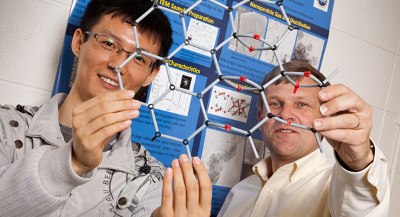A new semiconducting material, known as graphene monoxide (GMO), has been discovered by a research team from the University of Wisconsin-Milwaukee (UWM).
 Physics Professor Michael Weinert and engineering graduate student Haihui Pu display the atomic structure on GMO.
Physics Professor Michael Weinert and engineering graduate student Haihui Pu display the atomic structure on GMO.
The material is synthesized from graphene that belongs to the carbon family and has the potential to advance electronics, as it conducts electricity better than copper and gold wires utilized in existing devices. However, graphene now has limited applications because mass production of the material is very expensive. In addition, graphene-related materials are available only as insulators and conductors. Hence, graphene researchers focus on transforming the material into a semiconducting one for electronic applications.
GMO possesses characteristics that will enable easier upgrade than graphene. Additionally, the carbon-based material is semiconducting, which is essential to control the electrical current in a strong conductor as graphene. Through the innovation, the carbon family now has all the three features of electrical conductivity, semiconducting, insulating and conducting, which helps to advance the use of carbon materials in next-generation electronics.
UWM team developed GMO while exploring the performance of a hybrid nanomaterial, created by Junhong Chen, professor of mechanical engineering at the university. The hybrid material is used by Chen to produce inexpensive, energy-efficient and high-performance sensors. The team created four new materials, which are collectively refereed as GMO. They recorded the process by using Selected Area Electron Diffraction (SAED) technique in a transmission electron microscope. As GMO is produced in the form of single sheets, the material can have applications in products that undergo surface catalysis. Researchers are also investigating the use of graphene-based semiconducting material in the anodes of lithium-ion batteries.